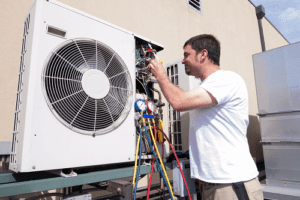When looking at any HVAC system, it’s always best to compare it to other systems to highlight where the distinctions are. Multi-stage heating and cooling systems are an alternative to single-stage systems and possess many advantages, making them an increasingly frequent option for homeowners who want to invest in a new system.
Most of the differences between these kinds of heating systems are in the electronics rather than the mechanical parts. Most types of HVAC systems can be installed with either approach to its controls and functionality. Below, we examine how multi-stage systems work and what benefits they offer for your home.
How Multi-Stage Heating and Cooling Systems Work
 There are several variations on the multi-stage heating and cooling system. The thing that brings them all under the same category is that they grant you the ability to use different settings for your HVAC system. Each system may offer varying degrees of control, but the most common variation is between “high” and “low” settings. Some may offer a third option, and the system may be multi-stage with either the heating, air conditioning, or both.
There are several variations on the multi-stage heating and cooling system. The thing that brings them all under the same category is that they grant you the ability to use different settings for your HVAC system. Each system may offer varying degrees of control, but the most common variation is between “high” and “low” settings. Some may offer a third option, and the system may be multi-stage with either the heating, air conditioning, or both.
To ensure that these settings operate correctly, your HVAC must be able to tell the temperature accurately. Most modern systems can do this with great precision, and it’s the same mechanism that single-stage systems use to determine its status of either on or off. For multi-stage systems, the switch must control the power output for the system’s motor. The lower settings will result in a system that heats or cools accordingly less, which can have a significant impact on the total amount of energy your system uses.
Comparing Multi-Stage Systems to Single-Stage Systems
These HVAC systems possess two major areas of distinction:
- Installation – Multi-stage systems involve slightly more components than single-stage systems. You’ll need greater temperature sensitivity, motors that can function at variable speeds, and another component to control which setting the system uses at any given moment. As a result, the installation is moderately more complex and likely more expensive up-front.
- Efficiency – Multi-stage systems truly shine when considering how efficient they are. In many cases, the lower settings for those times when it’s just a little too cold or a little too warm are ideal. Your HVAC system doesn’t have to ramp up to full power to make a minor adjustment, meaning that each time it turns on to manage the temperature uses less energy. Despite its efficiency, a multi-stage system doesn’t trade off any power. When you need the full strength of your HVAC system, a multi-stage system is no weaker than a single-stage.
Realistically, multi-stage systems represent an innovation over older, single-stage systems. There are very few reasons not to select a multi-stage system when installing a new system in your home.
Maintenance for Your Multi-Stage System
If you have much experience arranging for HVAC maintenance in the past, the good news is that you’re prepared to manage it with a multi-stage system. HVAC maintenance for multi-stage systems falls into the same categories as with single-stage systems:
- Preventive maintenance. You can accomplish this by ensuring that you regularly change the system’s air filters and wipe down the air vents. Another necessary step is to arrange annual or semi-annual duct cleaning to ensure that nothing accrues in your ventilation system.
- Repairs and emergency service. Any time your system experiences an electrical or mechanical failure, you need to contact a qualified HVAC technician to assist you. These issues may show up in your thermostat, power supply, or internal components that control whether the system turns on or not. Technically, the more complicated circuitry means that one more thing can go wrong with a multi-stage system than with a single-stage system, but the added risk and cost is minimal.
Installing a Multi-Stage Heating and Cooling System in Your Home
We strongly encourage homeowners to consider making the switch to a multi-stage heating and cooling system when it comes time to upgrade or replace your old system. Not only does this add value to your home, but it gives you much greater control over your home’s temperature. This control lets you enjoy greater comfort and can save you significant amounts of money.
The installation process for these systems is as simple as any equivalent single-stage system, so any research you’ve done regarding the type of system you’d like to install is still relevant. Experienced HVAC contractors can walk you through the process so that you know what the installation will cost and how long it may take to complete. Soon after you arrange to install your new system, you and your family will be able to enjoy climate-controlled temperatures to ensure that the air is just right, all year round.

